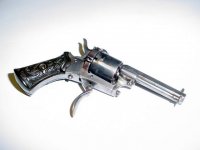toolingking
Cast Iron
- Joined
- Dec 31, 2005
- Location
- seekonk, ma. 02771
i need a little help on finding out what i really have here. i bought this gun around 40 years ago from a guy that was well into his eighty's at my gun club. he told me then it was a french teat fire but a local gun store told me it was a pin fire. the hex barrell has some rifling in it and the bore measures .204-.205 barrell length 2.170 the only markings on it are on the barrell it has a (z) and (star) symble and on the cylender it has (e) (l) (c) (star) . its got a 6 shot cylender stamped with (6) on it. folding trigger with a push rod for the empty cartridges. all the screws on the gun are fillister head style. there are some problems with the indexing of the cylender when you cock the hammer back. so my question is DO I HAVE SOMETHING HERE OR NOT as far as value goes. going to try to post pictures. thanks for any help. kenny
rumford supply & machinery company
[email protected]
rumford supply & machinery company
[email protected]
Attachments
Last edited:





